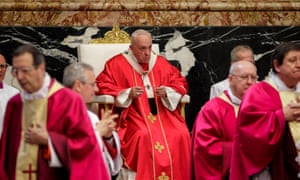Pope Francis may consider ending the celibacy of the parish clergy, at least if local bishops want him to. That much seems clear from the confused reports and counter-reports emerging in advance of a conference of Amazonian Catholic bishops in Brazil.
This is a special case of a more general problem affecting the church worldwide. There are far fewer men coming forward for ordination than it needs. In France the average age of the clergy is over 60; in Ireland Maynooth seminary, built to train 500 priests a year, this year had only six new entrants.
Ending the celibacy of the parish clergy is something any pope could do with a stroke of the pen. It wouldn’t require a change in doctrine. And in some limited cases it has already been ended in the west. Former Anglican priests in Britain and the US have become married Catholic priests; members of the eastern rite Catholic churches serving Ukrainian immigrants in the US have married clergy, just as they do in their homeland. But bishops all around the world are keen for this disruptive pattern not to spread. The Anglican experiment was established in the teeth of resistance from the English Catholic hierarchy, and is clearly going to die out within a generation, since no new married men are to be ordained.
The bishops’ hostility is easy to understand. A married clergy would break the economic and cultural basis of the church in the west. Parishioners would have to pay for the priest’s family, who would need a house as well as an income; the priest would belong to his family as well his flock; there would be divorces, as there have already been in the US. Clergy who had already signed up for a celibate life would be full of resentment at others not having to make the same sacrifice. Yet the present situation looks increasingly unsustainable.

What makes the Brazilian case unique is that the pressure for a married clergy appears to be coming from the local bishops. In 1970 92% of Brazilians identified as Catholics; by 2010 that figure had dropped to 65%. Almost all the loss was accounted for by the rise of Pentecostal churches, which allow married leaders and offer far more public roles to women, along with a theatrical form of Christianity.
There are still 140 million Catholics in Brazil today, but only 18,000 priests to serve them. In the Amazon regions, the problem is most acute. Efforts to import priests from elsewhere in the country have largely failed, because of cultural differences. Elsewhere in the world, especially the US and western Europe, a shortage of home-grown priests has been patched over by importing them from the developing world. But that works only in countries with a language, such as English or Spanish, that is spoken globally. That’s not the case for Brazil’s Portuguese speakers.
One thing is absolutely clear. If this change is made, it will not be imposed by Rome, and it will not be global. Pope Francis is already facing furious resistance to his efforts to soften church attitudes to remarried divorcees. The Anglican example shows how bishops otherwise regarded as liberal can reject a married clergy when they feel it is imposed on them.
A suggestion that the next worldwide gathering of bishops in Rome discuss celibacy has been voted down by the preparatory group. But if the Brazilians decide they want it, and possibly even more radical measures – such as a greater formal role for women in the parishes – Pope Francis won’t stand in their way.
• Andrew Brown is a Guardian columnist







View all comments >
comments (729)
Sign in or create your Guardian account to join the discussion.
“Is the celibacy of Catholic priests coming to an end?”
For a substantial proportion, I wasn’t aware that it have even started.
Bingo!
Supressing sexuality seems to lead to it manifesting itself in slightly different ways.
Well, exactly. It's common knowledge that there's a lot of flouting of the rules as it is.
If we were being cynical, we'd believe the rumour that the celibacy rule introduced in 1123 AD (as priests were allowed to marry before that) was actually brought in to stop priests from leaving their assets to any family they might have instead of the church as opposed to any other more religious reason.
That’s not really a rumour, more accepted historical fact. The Church in the Middle Ages was basically a property portfolio with its own army and laws.
Bishop Bennan will be delighted.
Good old Len.
How's the son?
The Son of God, Len!
Is the Pope a Catholic? Is he, seriously....?
The Pope loves to tango!!! He is OK in my book for this fact alone.
No. He is a romantic Catholic. Sic.
Well, Jesuit if we want to be uber-nitpicky about it.
Married priests is pretty much the de facto state for Africa's 140 million catholics.
It's unnatural, in pursuit of the supernatural. How this sort of thing can persist for hundreds of years and still be controversial in this day and age seems crazy to me. I say let them argue endlessly over it, but the priests still want to tell everyone how to live. They are the worst hypocrites of them all.
I think the fact that the celibacy of priests has endured for many priests, in the Catholic church, demonstrates the power of indoctrination.
The whole idea that normal men should forego a natural urge and self sacrifice is nonsense.
No wonder there are so many cases of sexual abuse relating to the priesthood.
The curious thing is I always feel at my most theistic after a bit of an old shag.
Could be worse, it could have been a bit of Scooby.
Well, as this nonsense is made up, why not change the made up nonsense to suit the times when it becomes a bit tricky?
World will keep revolving and it'll make no difference whatsoever except to those who, presumably have nothing better to do choose to make it so.
The utter waste of human energy drives me to despair.
As if they have ever been celibate...
Exactly.
I heard it was a transcription error by a careless monk.
What god really said was that they should _celebrate_ their sexuality.
Either that or we have women priests
Or both.
They should just hire extremely attractive priests, both male and female. I've always said the problem with the clergy is that there aren't enough lookers among them.
ooooh no. God wouldn't have wanted it ..... shame JC didnt do a last minute Q&A but I think he was preoccupied
We used to have a priest come to our house to get my mother back into the flock. He used to chase her round our table. That never encouraged her at all.
I bet it kept her fit. Better than a Gym Club?
Laughing at inappropriate behaviour eh?
Reminds me of the old joke:
-Was she chaste?
-Yes, I chased her all over the place, but I couldn't catch her.
(It doesn't work when written down, of course.)
All the Catholic couples I know use birth control, such as condoms, pills, spay and neuter :) :) :)!! Good!
That would be an ecumenical matter .
Girls!
Yes.
Drink!
I am still impressed that he has not had an "accident". He has certainly changed a lot of things. All kind of respect to the man
Yes he has rolled the turd in a fair amount of glitter .
For example?
Well, he actually appears to be a decent person, that's a change.
How about the Pope decides that he fesses up about all the mumbo jumbo being phony nonsense. Then all those dress loving priesties can do what they like.
Yeah, but then they'd have to actually go out into the real world and find jobs, homes etc for themselves.
It's exciting to think organised religion might literally die out in ones lifetime. To the critical point where absence of religion was considered the least criterion for being a developed nation.
As I look at the world today, I suspect your excitement is a tad premature.
They thought that had happened in China a few decades back. Then there was the greatest numerical revival in world history.
Whilst the Eastern Rite Catholic Churches have married priests yet there priests cannot marry, matrimony has to precede ordination.
True. Also, in Greek Orthodoxy, a married priest is unlikely to be promoted much beyond the grade of parish priest. The higher echelons in the Church hierarchy are occupied by the unmarried.
Celibacy in the Catholic church has always been something of a grey area, to say the least.
It would be more accurate and honest to title this article: 'Is the non-married status of Catholic priests coming to an end?'
Good. It's a sign young people are getting smarter and turning away from religion. Long may it continue.
You mean young First Worlders, right?
It's good whoever's doing it, in my book. And if the pool of people who fancy being priests in those developing countries is draining through this exodus, then that can only accelerate those countries' development.
Yes.
Priests weren't always required to be celibate. I think the change came in the 12th century but I can't remember the exact date. Priests could be married with families who helped to farm the glebe and assisted him. I seem to remember the change came when there was a particularly strict pope who regarded women as the cause of all evil. Some scholars postulated that women were a different species. Now we know that God was only experimenting when she made Adam first. Perfection came with the second try.
I remember reading that monks and nuns were often married (to each other) and lived in joint communities but that was pre-12th century.
The clergy of the early Christian Church (in Apostolic times), being in essence mostly Jewish and therefore used to the idea of a married priesthood (all rabbis were married), were expected to be married. ("A bishop must be blameless, the husband of one wife." 1 Timothy 3:2).
St Paul was celibate and championed the single life as a better choice and a higher calling, enabling the individual to dedicate him/herself entirely to God (see 1 Corinthians 7), but he realised that marriage is the normal state for any Christian, including the clergy. Even in Saxon times in England, priests used to marry, but the Norman Conquest put a stop to that.
You are clearly not a Christian scholar yourself, so let me reccomend you Luke 18:28–30, Matthew 19:27–30 and Matthew 19:12, for starters, and then you can move to Cannon 33 of the Council of Elvira (circa 305 AD) and the Cum in unum decrees of Pope Siricius (circa 385 AD). You can take it from there.
Believe or get shafted for eternity.
Thank you, forgiving Lord, for all those options!
Sign in or create your Guardian account to recommend a comment